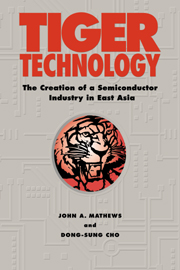Book contents
- Frontmatter
- Contents
- List of Figures
- List of Tables
- Preface
- Abbreviations
- Introduction
- Part I The ‘Real’ East Asian Miracle
- Part II National Institutional Pathways
- Part III The Technology Leverage Strategy
- 6 East Asian Semiconductor Industries: National Strategies and Sustainability
- 7 Limits to Technology Leverage Strategies
- 8 National Systems of Economic Learning: Lessons from East Asia
- Appendix I Exchange Rates: 1975–97
- Appendix II Chronolog
- Glossary
- Bibliography
- Index
8 - National Systems of Economic Learning: Lessons from East Asia
Published online by Cambridge University Press: 09 October 2009
- Frontmatter
- Contents
- List of Figures
- List of Tables
- Preface
- Abbreviations
- Introduction
- Part I The ‘Real’ East Asian Miracle
- Part II National Institutional Pathways
- Part III The Technology Leverage Strategy
- 6 East Asian Semiconductor Industries: National Strategies and Sustainability
- 7 Limits to Technology Leverage Strategies
- 8 National Systems of Economic Learning: Lessons from East Asia
- Appendix I Exchange Rates: 1975–97
- Appendix II Chronolog
- Glossary
- Bibliography
- Index
Summary
Our aim in this book has been to document, account and appraise the methods and achievements of the East Asian countries in establishing semiconductor industries. We have compared the variety of knowledge leverage strategies developed in East Asia in some detail: the long, patient process of leverage laced with autarchy pursued by Japan; the accelerated export-driven leverage strategy of the Koreans using large, diversified firms; the patient build-up of private sector capabilities using the leverage of the public sector in Taiwan; and the skilful leveraging of technologies from the multinationals in Singapore and Malaysia. Our aim has been to demonstrate that in creating a high-technology industry such as semiconductors, these East Asian countries have pioneered new strategies and techniques – not of technological innovation, but of industry creation itself.
They have developed a new and powerful focus for their efforts, not to generate new knowledge, but to accelerate the leverage and diffusion of existing knowledge, first from overseas advanced countries into their own institutions, and then from firm to firm within their own countries. We have sought to demonstrate how these East Asian countries have developed unique institutional frameworks adapted for this purpose – which in themselves constitute an important form of economic innovation. We have argued that the East Asian countries have pioneered the development of three institutional models of accelerated diffusion of technological capabilities, which we have designated in neutral terms as Models A, B and C.
- Type
- Chapter
- Information
- Tiger TechnologyThe Creation of a Semiconductor Industry in East Asia, pp. 313 - 330Publisher: Cambridge University PressPrint publication year: 2000



